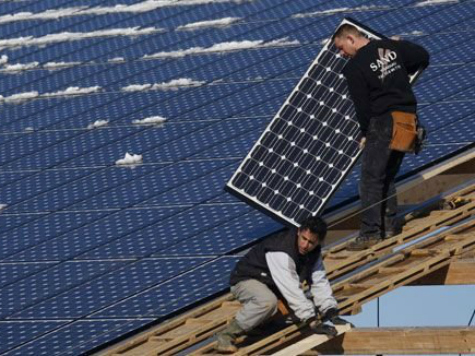
Barclays Investment Bank Research recently downgraded the entire U.S. electric utility sector because they believe that “a confluence of declining cost trends in distributed solar photovoltaic (PV) power generation and residential-scale power storage is likely to disrupt the status quo” for energy generation in America. The electrons generated by residential PV solar systems are “green,” but the electric current they send to the utility grid is referred to in the industry as “filthy,” since it is inherently variable, intermittent, and unreliable.
According to the Barclays report:
Based on our analysis, the cost of solar + storage for residential consumers of electricity is already competitive with the price of utility grid power in Hawaii. Of the other major markets, California could follow in 2017, New York and Arizona in 2018, and many other states soon after.
The concept of electrical generation with battery storage is not a new concept. The commercial electric utility business began on April 7, 1883 when the Hartford Electric Light Company (HELCO) cranked up its 50-horsepower coal fired steam engine, which belt-drove a 28-light electric generator to light up Hartford, Connecticut’s train station. Four years earlier a local textile manufacturer had installed electric arc lamps in its factory and got a huge gain in productivity over gas lamps.
However, the business almost went bankrupt because the intermittent availability of electrical power. Having to operate with both electric lamps and traditional gas lanterns available almost bankrupted the company. In 1896, HELCO installed a 300-ton, 400-kilowatt lead-acid battery to store surplus electricity in order to minimizing service interruptions caused by machine breakdowns. Once high reliability had been achieved, the utility business flourished across the United States as companies rapidly converted to cheaper electric power, and then residences started converting in 1908.
For over 100 years there has not been a scalable, cost-competitive overall substitute for carbon-based electrical grid power, despite billions of dollars of investment. Solar power by its definition is intermittent every night and is also affected by overcast skies and dirty PV cells. According to the U.S. Energy Information Agency, the “Total Levelized Capital Cost” of installing residential PV solar is competitive with a traditional carbon-based electric utility because there are no long-distance power lines and local distribution costs. However, the “Capacity Factor” availability of PV solar is only 25% or less versus 85% or more for carbon-based natural gas and coal-fired electric utility plants.
Residential PV solar system owners are not required to pay the hidden costs of intermittency abatement to have a carbon-based electric grid available 24 hours a day. Subsidies, preferential tariffs, and net metering schemes compound the problem by under-charging residential PV solar owners for their utility’s infrastructure. Investment tax credits for residential PV solar systems are patently unreasonable because the future economic benefits of the investment aren’t taxed at all.
Industrialized societies rely on three critical shared resources: clean water, clean air, and clean electric power. As energy expert John Pedersen has observed:
If the electric grid was a mountain stream, the current from PV solar would be like adding raw sewage. If the electric grid was clean air, the current from PV solar would be like a dung-fired power plant without scrubbers. We are catastrophically polluting one shared resource in the name of protecting another from real and imagined harm. It’s a widely ignored tragedy of the commons that ideologues, demagogues and hucksters would rather sweep under the rug.
The costs utilities pay to smooth out “filthy” electric current from residential PV solar and provide standby facilities for evening and overcast days are substantial. Those abatement costs are rolled into the rate base and paid by all the utility’s customers.
Utilities charge commercial customers a maximum “demand charge” of $10 to $20 per kilowatt hour, plus an “energy charge” of $.08 to $.12 per kilowatt hour. The demand charge represents the utility’s fixed infrastructure costs and the energy charge represents the variable cost of buying and distributing power. Residential customers only pay a flat rate because variation from house to house is expected to be minimal.
When a residential utility customer makes a business decision to invest in a PV solar system so that he can become a part-time power producer, that decision undermines the basis for a flat rate charge, because his power production and consumption patterns will be very different from all his neighbors. When utilities charge a residential tariff for a mixed residential and commercial use of the grid, the PV solar system owners abusively underpay their share of infrastructure costs.
States like California, that just passed SB871, provide substantial incentives to PV solar system owners, such as full residential tariff credit for their excess day-time power and a 30% Investment Tax Credit for buying a capital asset that generates long-term tax-free income in the form of avoided utility bills – despite the fact that PV solar system owners do not have to pay the infrastructure cost to redistribute electricity they don’t consume.
The concept of adding battery storage to the utility grid dates back to Thomas Edison. He explained to a New York Sunday Herald reporter in 1883 that he patented combining generators, batteries, and electric lights in 1879, but “Scientifically, storage is all right, but commercially as absolute a failure as one can imagine.” Utility energy storage is the “Holy Grail” of cleantech wind, solar, and emerging transportation applications. But this is constrained by laws of chemistry and requires massive volumes of commodity metals for raw materials.
PV solar promoters have gamed the government rules and regulations that control the electric utility grid. As the number of people that buy PV solar systems expands, eventually the vast majority of other utility ratepayers that are being financially gamed will politically rebel and shut the game down.
The author welcomes feedback and will respond to reader comments.

COMMENTS
Please let us know if you're having issues with commenting.